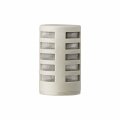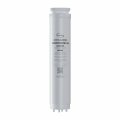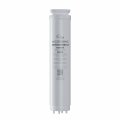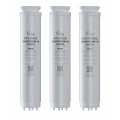iSpring RCD100HCG Hot & Cold Reverse Osmosis System Countertop, Alkaline RO Water Filter Dispenser, 9 Temperature & 6 Dispensing Volume Options, TDS & Filter Lifespan Monitor, Plug and Play
About this item
- [Hot and Cold RO Dispenser] - Experience the convenience of the cold and hot RO water filter system with the iSpring RCD100HCG. Featuring thermoelectric cooling technology, this alkaline reverse osmosis system operates quietly and delivers cold water efficiently while consuming less power and space compared to traditional compressor cooling systems. Designed with 9 temperature options and 6 dispensing volume options, it can be easily adjusted to meet different hydration preferences.
- [Convenient Dual Pitchers] - Incorporated with a dual-pitcher design, the reverse osmosis water filter countertop allows you to have filtered water available at your fingertips or stored in the fridge while the other remains operational in the system. It ensures continuous access to fresh, filtered water without the need for frequent refills.
- [1000+ Contaminants Removal with Balanced pH] - The advanced alkaline RO water filtration system eliminates over 99% of 1,000+ harmful contaminants, including PFAS (PFOA and PFOS), vinyl chloride, chlorine, fluoride, lead, arsenic, asbestos, calcium, sodium, and others. With alkaline filtration, this countertop RO system ensures great-tasting pH-balanced water whenever you need it.
- [Real-Time Monitoring and Safety Features] - The smart panel of the iSpring RCD100HCG countertop reverse osmosis system offers real-time monitoring of source water and filtered water TDS levels, along with temperature display and low water level reminders. Additionally, enjoy customizable dispense volume and added peace of mind with the child safety lock feature. The system also includes a 10-second auto flush process upon opening or closing the source water tank cover, extending the lifespan of filters.
- [No Plumbing & Filter Lifespan Monitor] - Designed for convenience, this reverse osmosis system countertop requires no plumbing, making it suitable for any location with a power outlet, including households, offices, and RVs. With a 100 GPD capacity and up to 2.5:1 pure to drain water ratio, the portable reverse osmosis system efficiently meets various water needs. The RO water dispenser includes filter life monitoring and features a twist-and-lock design for easy filter replacements. For replacement filters, please search for "FPCA100" & “MCD100HC”.
Frequently Bought Together

iSpring RCD100HCG Hot & Cold Reverse Osmosis System Countertop, Alkaline RO Water Filter Dispenser, 9 Temperature & 6 Dispensing Volume Options, TDS & Filter Lifespan Monitor, Plug and Play
- Availability: In Stock
- Model: RCD100HCG
Write Review
-
 iSpring FNF100 Stainless Steel Filter for RCD100 Countertop Reverse Osmosis System, Rinse Every 3-6 Months
$8.99
iSpring FNF100 Stainless Steel Filter for RCD100 Countertop Reverse Osmosis System, Rinse Every 3-6 Months
$8.99 -
 iSpring FPCA100 Replacement Filter for RCD100HCG Countertop Reverse Osmosis System, Composite Filter, With PP Sediment, Activated Carbon and Alkaline Media, Replacement Cycle: Up to 12 Months
$59.99
iSpring FPCA100 Replacement Filter for RCD100HCG Countertop Reverse Osmosis System, Composite Filter, With PP Sediment, Activated Carbon and Alkaline Media, Replacement Cycle: Up to 12 Months
$59.99 -
 iSpring MCD100HC RO Membrane Replacement Filter for RCD100HCG Countertop Reverse Osmosis System, Replacement Cycle: Up to 24 Months
$59.99
iSpring MCD100HC RO Membrane Replacement Filter for RCD100HCG Countertop Reverse Osmosis System, Replacement Cycle: Up to 24 Months
$59.99 -
 iSpring F3RCD100HC replacement filter pack for RCD100HCG
$159.00
iSpring F3RCD100HC replacement filter pack for RCD100HCG
$159.00
-
Start Download
RCD100HCG Manual.pdf
Replacement Filters & Parts
Filters:
I keep getting reminders to refill my system, even though there's still water left in the tank. Why?Dear customer, it is important to understand that waste water is generated during the filtration process of any reverse osmosis system, including the iSpring RCD100HCG. This waste water is stored separately within the tank after the filtration process is complete. To maintain optimal system performance, please ensure that you completely empty the tank before refilling it. Why does the baffle in the tank sometimes allow waste water to flow back into the source water section? Will this affect the quality of my filtered water?Rest assured, this won't impact the quality of your filtered water. In fact, it's part of the innovative design aimed at maximizing the use of source water and minimizing waste. The waste water is cycled back into the raw water tank and initially mixed with the raw water. As it accumulates more contaminants, it's separated in the waste water cube to prevent it from being filtered again, ensuring the RO membrane isn't exposed to water outside its optimal range. So while it might seem unusual, it is actually a deliberate feature designed to optimize the system's efficiency and resource utilization. I noticed that my source water TDS is around 500 ppm and the output is around 50 ppm. However, I also have a traditional 5-stage RO system installed which can reduce TDS down to 30 ppm. Is this level of TDS reduction normal for this system?Yes, please rest assured that it's completely normal. Unlike traditional 5-stage RO systems, the RCD100HCG is specifically designed to not only remove contaminants but also replenish beneficial minerals to balance pH levels and enhance taste. This mineral addition contributes to a slightly higher TDS reading. It's crucial to understand that while reducing TDS is important, it's not the sole factor determining water quality. According to the EPA, TDS is considered as a secondary standard for drinking water quality. Instead of solely aiming for extremely low to zero TDS, it's important to find a balance between eliminating harmful contaminants and preserving essential minerals. Additionally, regular maintenance such as filter replacements and sanitization of water tanks is also crucial for maintaining optimal performance and water quality. I've heard about this thermoelectric cooler thing. What exactly is it and how does it compare to the standard compressor cooling approach?Thermoelectric cooling technology is an innovative cooling method that offers several advantages over traditional compressors. It consumes less power, takes up less space, and operates more silently. While they may produce cold water slightly slower than compressors, as long as the system has a maintained power supply, there is no noticeable gap or delay in the user experience. Additionally, thermoelectric coolers require minimal maintenance, making them a convenient and efficient choice for water cooling systems. However, please note that the lowest temperature that can be reached with thermoelectric coolers is 50°F, slightly higher than the 41°F that compressors can achieve. While this difference may not be significant for most users, it's something to consider depending on individual preferences and needs. |



















 RCD100HCG
RCD100HCG FNF100
FNF100
 FPCA100
FPCA100
 MCD100HC
MCD100HC
 F3RCD100HC
F3RCD100HC















